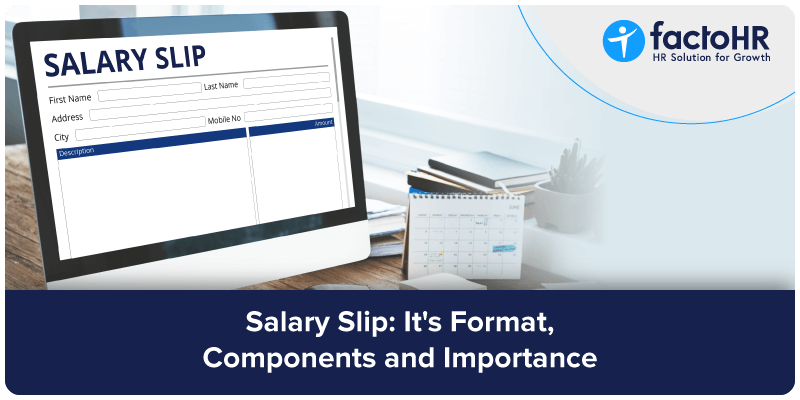Free Salary Slip Generator – Download Payslips in Seconds

Table of Contents
Free Payslip Generator
What is a Payslip?
A payslip also called a wage slip or salary slip is a document the employer gives to an employee. It clearly shows your earnings, deductions, and other payroll details. A Payslip format includes details like gross earnings (including basic pay and allowances) and deductions (including taxes and insurance).
Steps to Create Your Salary Slip Using Payslip Generator
There is a step-by-step and user-friendly process to how to make salary slip. Our payslip generator can be created in just a few steps with customizable templates, along with maintaining compliance with laws. Here are the steps below:
- Step 1: Fill in the basic details about the company, which include name, logo, address, and many more.
- Step 2: Include employee information, which includes employee ID, designation, PAN, and bank details.
- Step 3: Income details like basic salary, allowances, bonuses, and deductions (for example, taxes and provident fund) should be entered.
- Step 4: Lastly, preview or download the generated payslip in PDF format.
Understand Salary Slip Format
There are multiple formats of salary statements that an organization follows. Some of the basic elements remain the same, which are mentioned below:
- Header Info: Start with pay period, employee name/ID/PAN, and other important details to confirm the document’s context and validity.
- Review Earnings Breakdown: Check gross pay components like basic salary, HRA, conveyance, medical, and other allowances to calculate total income.
- Check Deductions: This includes statutory (PF, ESI, PT) and voluntary subtractions (TDS, loans), which are calculated to determine the salary.
- Calculate Net Pay: Subtract deductions from earnings to verify take-home salary.
- Verify Extras: Review attendance (days worked, leave), overtime, and any employer contributions.
Key Components of a Payslip
Earnings Section
Basic Salary
It is the total amount of earnings by an employee before any allowances or deductions are made from their salary structure, which is up to 30-50% of the total package.
HRA (House Rental Allowance)
Employees who are living in a rental house can claim HRA to cover the expenses of rental accommodation. Using the HRA Calculator, employers can easily understand how much exemption their employees can claim.
DA (Dearness Allowance)
Dearness allowance is offered to support the employees against inflation, which is decided based on the cost of living and the employee’s location.
Leave Travel Allowance (LTA)
In Leave Travel Allowance, companies need to track all travel-related expenses. Using expense management software makes it easier for HR teams to record and manage these costs.
Performance Bonus
Employers provide bonuses based on employees’ performance, which are considered taxable, and the amounts can vary across organizations.
Medical Allowance
Employees can claim this allowance by providing supporting documents for medical treatment costs incurred during their employment period.
Conveyance Allowance
Companies provide this allowance to cover employees’ traveling costs between the workplace and their residences.
Deduction Section
TDS (Tax Deducted at Source)
This is the advance tax deducted from an employee’s earnings and deposited with the government on their behalf. Businesses/employees can estimate their income tax amount with our income tax calculator to know more tax liability.
Professional Tax (PT)
Professional tax is a payable amount based on the employee’s salary. It is an amount deducted from an individual’s salary, and it varies across states in India.
Employee Provident Fund (EPF)
It is a mandatory saving scheme in India where both the employee and employer contribute towards the EPF account of the employee. It is monitored by the Employee Provident Fund Organization (EPFO) and includes benefits like pension and insurance.
Importance of Employee Salary Slips
Proof of Employment
Employees can use payslips when they are required to provide legal proof of employment. If employees apply for travel visas, they may need to provide a copy of their payslip as proof of their most recent salary and job title.
Salary Slip for Pay Negotiations
A payslip can be helpful when negotiating with potential employers about the total CTC and its components (e.g., basic salary, deductions, etc.). Most employers ask for employees’ past payslips to verify employment and earnings.
Easy Income Tax Planning
A monthly salary slip shows a breakdown of an individual’s total earnings, deductions, and taxable components. The break-up of deductions includes professional tax, TDS, ESIC, and EPF.
To Avail Loans/Credit Cards
This document can be used as legal proof of an individual’s credit-paying ability, i.e., when availing credit cards, loans, and mortgages. Banks or NBFCs can verify the creditworthiness of an individual based on the information from salary statements.
Conclusion
Organizations should know that a reliable free payslip generator can simplify payroll cycle management and help maintain compliance. There are multiple vendors that can help save time and reduce errors when it comes to payroll processing. This includes automated calculations and customization in the payslip.
Using a payslip generator is necessary to simplify HR operations and boost employee satisfaction. Companies can focus on growth and long-term success with automation with factoHR’s payslip generator.
FAQs
What is a Salary Slip Generator Tool?
A salary slip generator tool creates professional payslips for employees, including earnings, deductions, and net pay details. These tools are cloud-based and free for basic use. Know the difference between gross pay vs net pay to understand the topic better.
Can I Customize the Payslip Template?
Yes, you can customize the payslip template. Our generator allows customization, like adding a company logo and other specific fields.
Do I Need to Install any Software to Generate the Payslips?
No, these tools are fully cloud-based and work online without any software installation. These can be used via web browsers on any device.
Can I Remove or Hide Specific Components on the Payslip?
Yes, you can remove or hide specific components on the payslip. Our tool allows you to select which fields to display, so you can easily hide any salary component you do not want to show.
Can I Generate Payslips for Multiple Employees?
Yes, our salary slip generator helps you to generate bulk salary slips for multiple employees at once. It works for small teams as well as large organizations.
Is Disclosing Salary Details Legal in India?
Employees should not share information about their salary packages and offered benefits. There is no specific rule from the government, but some companies may have clauses (in employment contracts) that clearly prohibit employees from disclosing their salary details.
Grow your business with factoHR today
Focus on the significant decision-making tasks, transfer all your common repetitive HR tasks to factoHR and see the things falling into their place.

© 2026 Copyright factoHR


